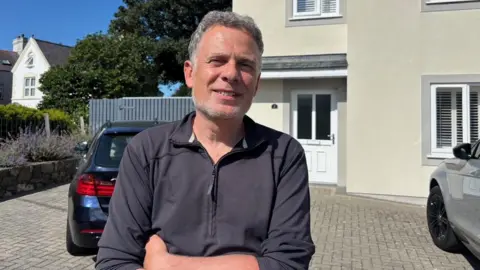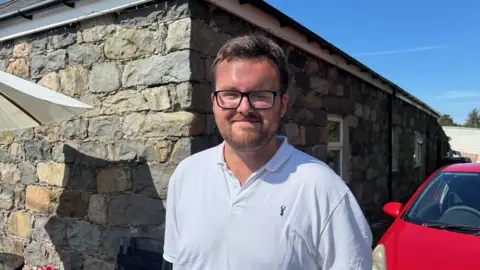 BBC
BBCThe number of properties bought as second homes in a Welsh county has decreased in the last year, according to its council.
In September 2024, Cyngor Gwynedd introduced a requirement for owners to get planning permission to turn a residential property into a second home or holiday let as part of efforts to address a housing shortage.
Figures show 250 homes were bought as second homes in Gwynedd between July 2024 and June 2025, down from 290 a year earlier.
While the policy has been criticised by some second home owners, one resident said the initiative was saving communities.
Research by the local authority show across the county, 65% of people were being priced out of the housing market.
The council said its priority was to ensure “sustainable communities”, with Gwynedd under “significant pressure” because of a lack of appropriate housing.
At the time, some campaigners said they feared the rule, known as an Article 4 Direction, could make it harder to sell homes and could cause some homes to lose their value.
According to the Principality Building Society, the average price of homes in Gwynedd has decreased by 7.2% in the last 12 months.
House prices remain high, however, with the average house costing £288,800 in Gwynedd compared with £238,098 across Wales.
But the policy remains controversial for some, as some residents in Gwynedd say the measures have led to more people choosing to sell their homes.
William Owen lives in Nefyn and is currently converting his old family home into a holiday let.
“Morfa Nefyn has been a place where people come on their holidays for years and instead of me selling this home as a second home, it will now mean people can come here and spend money locally,” he told Newyddion S4C.

Though Mr Owen said he agreed with the sentiment of the council’s efforts to ensure young people could afford to live locally, he disagreed with its policies.
“They sold all the houses, of what we used to call council houses, so why should we that own homes now have to pay for their mistakes?”
Like many local authorities, Cyngor Gwynedd also charges a tax premium of 150% on second homes.
Nick Brown owns a second home in the village and said he also understood what the council was trying to do, but was sceptical of the impact of its measures.
“I think it’s gone a bit too far. I think the real problem round here is jobs,” he said.
“Jobs are what people are after – it’s brought down prices.
“A number of people are selling up.”
Mr Brown said he was conscious of the impact owning a second home has and that the policy had made him think twice about owning one.
However, he does not believe Cyngor Gwynedd’s policies will lead to more young people being able to afford homes locally.

But Iwan Rhys Evans, 23, from Morfa Nefyn said the initiative was saving communities.
“The only thing we want is to protect our Welsh-speaking communities. We have nothing against English people or tourism,” he said.
“But at the end of the day if you come here, don’t disrupt our communities because once they are gone, they’re gone.”
Mr Evans also said there was a notable increase in the number of homes in the village up for sale.
Cyngor Gwynedd said its priority was to ensure the viability and longevity of communities “by increasing access to affordable housing for local people”.
“The county is under significant pressure because of a lack of affordable housing,” it said.
“That’s reflected in that nearly 4,000 people are on our social housing register with 956 families presenting themselves as homeless between 2023-34.”
The council said it was increasing the housing stock and investing £70m.
“The council will be evaluating and constantly monitoring the policies that have been put in place to respond to the housing crisis,” it added.

